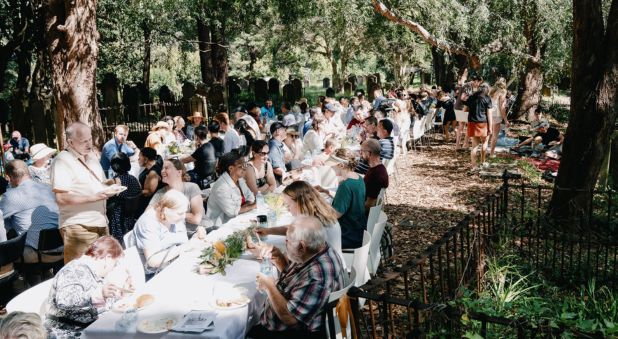A parish that was so small 50 years ago it didn’t even celebrate its church’s centenary, last month joyfully gave thanks through the word, music, prayer and song for the building’s 150 years of ministry in Newtown.
“I think it was a fabulous celebration,” says the rector of Newtown and Erskineville, the Rev Dr Andrew Errington. “The church was pretty full, we had a whole bunch of people connected to the church in the past came back – which was wonderful – and the day was just full of joy.
“The really wonderful thing about the celebration from my point of view is it played a part in enabling the community to have a sense of real ownership of the building.”
The church of St Stephen’s – a Gothic revival, Edmund Blacket-designed building constructed between 1871 and 1874 – replaced the original church (built in 1844), because Newtown was growing so quickly.
While the suburb is now a pretty secular place, the organisers of the sesquicentenary celebrations sought to include events that would appeal to a wide range of people and “showcase the building” to the community: a performance of Handel’s Messiah just before Easter with profession musicians; a history of deaconesses at Newtown (including the first in the Diocese, Mary Schleicher); and a special service of evensong on April 9 – the anniversary itself – using the Book of Common Prayer as would have been done 150 years ago.
One of the readings chosen for the evensong was 1 Corinthians 3:10-17, also used at the laying of the church’s foundation stone in 1871: “For no one can lay any foundation other than the one already laid, which is Jesus Christ” (v11).
The major celebration on Sunday, April 7 was attended by the Governor of NSW, Her Excellency the Hon Margaret Beazley, as well as Bishop Michael Stead, the acting principal of Moore College the Rev Dr Simon Gillham and a mission team from the college – followed by a lunch set up on tables flowing right through the adjoining cemetery.
Ups and downs
Extraordinarily, after many ups and downs in the church’s life – which included only six locals at the induction of part-time rector the Rev Alan Nichols in 1974 – Dr Errington says there was a plan to move the church, brick by brick, to Canberra and rebuild it as the national cathedral. Thankfully Mr Nichols, who was also working full-time for the Anglican Press Service (now Anglican Media) while at Newtown, began a period of renewal in the church so that, in 1979, the plan was finally refused.
Because of what he terms the “wild ride” of its history, Dr Errington observes that the 150-year-old church, and its congregation, feels very young. But he rejoices in knowing “that the ministry we’re engaged in now is very similar to the kind of ministry when the church began. Robert Taylor, who was the rector when the church was built, was a really Reformed and evangelical fellow, and the church bears the mark of that in a number of ways. So, we had a sense of the church returning to its roots, which is really lovely story to be able to tell.”
This sense of keeping to the truths of God’s word over time was also the theme of Dr Errington’s sermon from Hebrews 10 at the Sunday celebration – especially in giving thanks to our faithful, promise-keeping God:
“Although a place of worship cannot, and must not, be the source of our confidence to approach God, it can and should be a marker of the work of God by his Spirit. A church building is a tangible, visible expression of a community’s faith, an outward sign of its confidence that by the blood of Jesus ‘a new and living way’ has been opened. A church building is not a temple of God; but it can be a sign that there is such a temple: that God’s Spirit dwells in us because of Jesus Christ.”

























